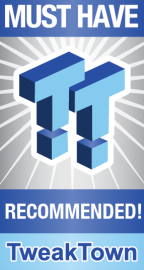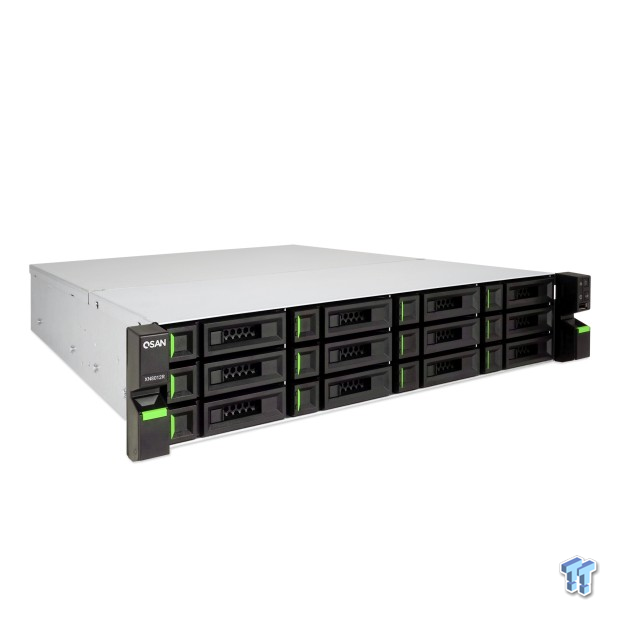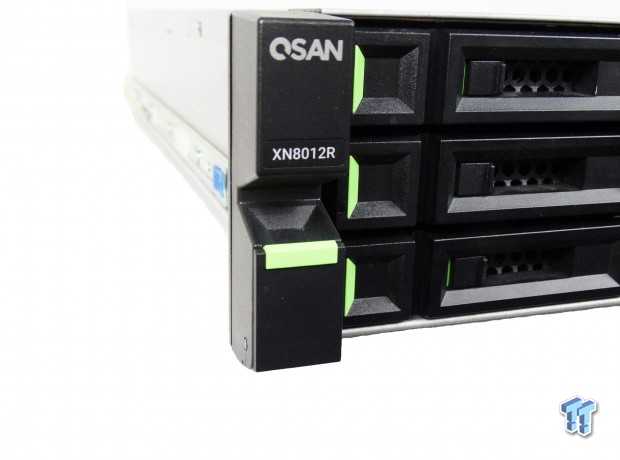
The Bottom Line
Introduction, Specifications, and Pricing
The QSAN XN8012R is a business-friendly NAS that sports features once reserved for datacenters. The 18-bay NAS utilizes the resilient ZFS file system, six dedicated bays for low-latency drives, and speedy connectivity options.

The QSAN XCubeNAS XN8012R is more than just a NAS we're testing for a review. This is our new NAS HDD test system that increases our drive capacity. The system also allows us to test SATA and even NVMe drives in cache roles sitting in front of disk storage.
Before we get too deep into testing and future roles, let's look at the basic specifications and the user interface.
Specifications

The heart of the system is Intel's Kaby Lake architecture quad-core Xeon operation at 3.3GHz. This series supports up to 64GB of system memory, although the XN812R ships with 8GB from the factory. If you utilize a large SSD cache in the storage array, you will want to maximize the DRAM capacity.
The 2.5" disk options are what make this system stand out from other systems. On the main storage side on the front of the system, you get twelve 3.5" drive bays. With modern disks, that's a speedy array already. If you want to increase performance, especially for random workloads, the system has six 2.5" bays in the back for cache or tiered storage.
You are not limited to just flash with this system, though. Two of the six bays support 2.5" 15mm z-height NVMe SSDs, and that opens the door for Intel's Optane SSDs like the 900P or the enterprise version, DC P4800X. The four other 2.5" bays use standard SATA 6Gbps, just like the twelve bays in the front. The system does not utilize SAS on any drive bay.

From the factory, the system ships with four 1GbE network ports. Two PCI Express slots for half-height cards provide expansion for 10GbE and/or Thunderbolt 3 high-speed connectivity.
On the back, we also found four USB 3.0 ports and a single HDMI port for additional connectivity. This is where we also found the hot-swappable redundant power supply.
Pricing and Warranty
Advanced Computer & Network Corporation (AC&NC) just signed a distributor agreement with QSAN to deliver products in North America. Administrators can configure and purchase XN8012R systems from AC&NC and take delivery within three days according to a recent press release.
The QSAN XCubeNAS XN8012R carries an MSRP of $3999. QSAN backs the XCubeNAS XN8012R with a standard 3-year warranty.
A Closer Look

The twelve 3.5" drive sleds take up the majority of the front face of the system. QSAN used lime green accents for the system. If Kawasaki had a datacenter, it would be filled with this series.


The green tips in these two images fold down to give system administrator's leverage to pull the system from the rack. On the right side, there is a power button and a UID button. The UID flashes an LED in the front and back of the system, making it easy to location in a populated rack. A network activity and status LED sit to the side of the two buttons.
Finally, there is a USB 2.0 USB port on the front just under the buttons.


The system doesn't ship with rack rails from the factory. The rails add convenience in highly populated racks. On the right, we see some of the build quality and effort QSAN put into the design. Many companies would have just used two screws to secure the ear to the chassis, but QSAN used three. The company also used five screws for the fascia instead of two found on lesser systems.



We divided the back of the system into three sections. The first shows the dual 250W power supplies for interruption-free redundant delivery. To the right of the PSUs is the 2.5" (SFF) bank of drive sleds. The four to the left utilize SATA 6Gbps, but the two to the right accept larger 15mm z-height drives, the common size for enterprise NMVe "U.2" SSDs.
The 4x gigabit Ethernet and USB 3.0 ports sit in the middle on the backside. This is also where the UID LED, mute, and reset button sit.
The far-right side of the NAS has the single HDMI port and provisions for half-height add-in cards. Our system shipped fully loaded with a 10-gigabit and Thunderbolt 3 (40Gbps) card installed.

Inside, we found a thoughtful layout with an emphasis on airflow. The system uses a tall passive CPU cooler that gets air from the three 60mm fans that sit between the CPU and the drives. An additional fan cools the SFF drive cage. The operating system sits on a single SATA DOM, so you don't lose the system's configuration swapping drives. This also allows you to maximize the disk storage. Some companies use the main media to hold the operating system.
CIFS Performance Testing
Testing Notes
We tested the QSAN XN8012R in three different configurations. All three configurations start with a base of twelve Seagate IronWolf Pro 12TB drives. The first test uses just the twelve HDDs. The second test adds a Micron 9300 Series NVMe SSD as a read-cache. The third tests uses four Seagate IronWolf 110 SATA SSDs for read cache, and two Micron 9300 Series SSDs for a write cache.
The XN8012R will only build write cache pools in RAID 1, so you can't use a single NVMe SSD for a write cache. This eliminates the possibility of using two NVMe SSDs for both read and write cache pools. The internal PCIe 3.0 slots do not work for storage devices, just network, and Thunderbolt, so you can't add a drive like the Memblaze PBlaze5 C916 with a PCIe 3.0 x8 interface.
We used a Thecus N8880U-10G for the comparison product in the charts today. The N8880U-10G was our former system used to compared NAS-focused storage products, so it's appropriate to compare it with our new system for testing the products going forward.
Sequential Read Performance

The sequential read test shows strong, predictable performance from the QSAN system. At 4 OIO the system outperforms the older Thecus N8880U-10G by around 100 MB/s. Both systems and all configurations peak at right around 1,200 MB/s.
Sequential Write Performance



The dots on the chart show the IO rate for every second. Dots appearing below the median line are outliers where the performance decreased. The QSAN configurations show less outliers than the older Thecus system. The QSAN configurations also write sequential data around 200 MB/s more than the Thecus in the preconditioning and steady-state phases of the test.
Sequential Mixed Workloads


With several workers operating on the NAS at the same time, the workload moves to mixed workloads as data comes and goes simultaneously. The QSAN's powerful processor allows the system to take advantage of the bidirectional nature of Ethernet. The workloads surpass the 1,200 MB/s limits that really only apply per direction, ingress and egress. Ethernet can push data in both direction at the same time, and that raises your throughput ceiling.
We wanted to see some extra performance coming from the two cache configurations with the XN8012R. The SSD cache doesn't improve sequential performance.
Random Read Performance


The two cache configurations instantly increase random read performance in the XN8012R. The system performs really well even without the flash drives compared to systems with only EXT4 or BTRFS file systems. The Thecus rides the floor of the chart in this test configured in EXT4. It also fails to scale as we increase the workload, and that's just the opposite of the QSAN system.
If you recall, the read cache configuration uses an NVMe SSD, and the read/write cache configuration moves the NVMe drives to the write cache, and the read cache comes from four Seagate IronWolf 110 SATA SSDs. That different read-cache technology is why we have such a large gap in the random read test. This will carry on through a few other tests as well.
Random Write Performance




We expected more from the read/write cache configuration in this series of charts. The Micron 9300 Series is a wicked NVMe SSD, but the XN8012R doesn't take full advantage of that power writing random data.
Random Mixed Workloads


With the random mixed workload test, we see more separation between the read and write cache configuration and the base configuration with just the twelve HDDs. The read-only cache with the NVMe SSD walks over the other configurations in many of the mixes.
Server Workloads
Database




In the database test, we see the read-write cache delivering better performance in the SX8012R when compared to the other configurations. This is a read heavy test, so we expected to see this type of separation. The read/write cache configuration with SATA SSDs on the read side does a good job outperforming the base HDDs only array.
The QSAN XN8012R in all configurations rips past the base Thecus N8880U-10G results in the database test.
OLTP




We see nearly identical separations in the OLTP test. The placement of the NVMe SSD makes a big difference.




The email server workload shows where having both a read and write cache can really benefit users by reducing latency under heavy conditions.
Archival File Server




The archive test comes from Dell's performance lab. This test measures performance with a mix of different block sizes, random and sequential data, and a mix of reads and writes. If you use your server for several roles at the same time, this is similar to how your server sees the different workloads with data moving in and out at the same time.
Web Server




Final Thoughts
The XN8012R is the second QSAN system I've tested in two years. It's interesting seeing the products mature as QSAN carves a niche not serviced by the other NAS providers. The systems are a throwback to some of the early NAS I tested when this category started heating up over a decade ago. QSAN's focus is on storage, storage performance, and adding storage features such as deduplication and compression. QSAN doesn't have a karaoke app, or other add-ons that no system administrator would allow in a serious environment. Eliminating the clutter to focus on the core is a welcome change after seeing NAS go through an era of bloatware like we saw with PCs since the 2000s.

For storage, the XN8012R is QSAN's most advanced NAS to date. The system incorporates the latest technology that system administrators lust for. The resilient ZFS file system is the foundation and allows advanced features like scalable compression and deduplication to maximize storage potential. The advanced cache and tier options provided by up to six SFF drives keeps the performance high by reducing the IO penalties from enabling the advanced features.
The system is just the start of your new infrastructure. With expansion, the XN8012R scales up to 2PB. That's quite a bit more than what the average business needs, but a large enough capacity to know future updates in infrastructure come at a lower CAPX than the rip and replace model from systems with less headroom.
In the article, we talked a bit about the XN8012R taking over the testing role for other storage products. We've already run over thirty tests with products like Seagate's new 16TB models (IronWolf, IronWolf Pro, and Exos), as well as flash-based products like the Micron 5120 Ion 4-bit per cell drives. The most exciting testing has come from comparing different cache drives including Micron's 9300 Series used today and Intel's 3D XPoint-based Optane SSDs. The system gives us the flexibility to explore more options that allow us to answer the questions system administrators need before committing to new technologies. The system is a welcome addition to the test lab that will serve our testing needs for years to come.
Performance |
96% |
Quality |
97% |
Features |
93% |
Value |
95% |
Overall |
95% |
The QSAN XCubeNAS XN8012R NAS is a flexible solution that provides powerful performance in a scalable package.

Related Tags
